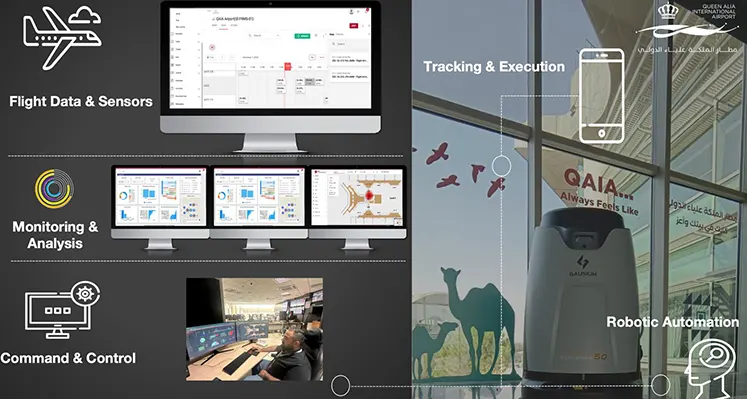
Smart cleaning innovation elevates QAIA passenger experience. (Image source: Queen Alia International Airport)
Queen Alia International Airport, operated by Airport International Group, has been honoured by Airports Council International with the Best Innovation in Airport Technology Award for its Smart Cleaning System
The award recognises a fully integrated, real time operational model developed under AIG’s leadership and implemented on site through its cleaning services partner, MENA Facilities Management, using the MIMS platform created by Arrow Labs.
The recognition highlights AIG’s long term strategy to modernise airport operations through digital innovation, data driven decision making and real time operational control. Within this framework, MENA Facilities Management is responsible for the daily execution of the Smart Cleaning System, applying the MIMS platform as part of the performance structure and operational standards defined by AIG.

The system brings together multiple data sources, including passenger movement patterns, flight schedules, IoT sensors, Building Management Systems and live feedback tools. This integration enables MENA FM to plan cleaning activities dynamically, respond quickly to changing operational demands and maintain consistent service levels throughout the terminal. Both AIG’s oversight teams and MENA FM’s operational staff benefit from improved visibility, coordination and responsiveness across airport facilities.
Since implementation, QAIA has recorded tangible operational gains, such as quicker response times, more efficient workforce deployment, improved transparency and higher levels of passenger satisfaction. The project demonstrates how AIG’s strategic direction, supported by specialised execution partners, can convert operational data into practical outcomes that enhance the overall airport experience.
“QAIA’s success reflects the strength of AIG’s visionary leadership, brought to life through close collaboration between a high-performing service provider and world-class technology,” said Rami Darwish, CEO, Arrow Labs.
He continued, “We are honored that our MIMS platform played a central role in this transformation. MENA Facilities Management’s commitment to service excellence and digital enablement was crucial in translating real-time operational intelligence into measurable performance outcomes. This award demonstrates what strategic leadership, strong partnerships, and continuous innovation can achieve.”
MENA Facilities Management plays a central role in turning digital insights into on ground execution, ensuring that the system delivers consistent performance across all airport areas.
“AIG’s dedication to digital innovation has been the true catalyst behind this milestone, and we are proud to have contributed as an integral operational partner. By adopting Arrow Labs’ MIMS platform, MENA FM has been able to enhance service delivery, optimise resources, and reinforce airport-wide coordination. This recognition is a clear testament to what aligned vision, advanced technology, and committed teams can deliver,” stated Aboud Abu Gharbieh, CEO, MENA FM.
As Jordan’s main international gateway, Queen Alia International Airport continues to strengthen operational excellence and digital transformation under AIG’s management. These efforts reinforce its standing among the region’s leading airports while supporting a smoother, more efficient travel experience for millions of passengers each year.









